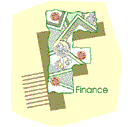When talking about bonds (especially when buying them) you have to take into consideration the yield of the bond. Simply put, a bond’s yield shows the relationship of the investment and the income. For the sake of comparability yield is always shown as an annualized (yearly) percentage.
 Current Yield
Current Yield
Although we may know the coupon rate of a bond that only shows the real yield of the bond if the bond was bought at par value and will be held till maturity. Current yield compares the yearly interest income with the current market price. If the bond was bought with a discount the current yield will be higher than the coupon rate, if it was bought with a premium it will be lower. Current yield is calculated with the following formula:
CY= 
Holding-period Yield
This yield is used when the investor knows when he will sell his bonds. In this case we use an estimated selling price instead of the face value.
Yield to Maturity
Yield to maturity is the rate at which if we discount the incomes (cash-flows) of the bond, we get the par value exactly. This yield is used most because it takes into consideration all future incomes and also their change over time.
Simplified Yield to Maturity – SYTM
Yield can be calculated many ways. There are bond-tables from which you can calculate yield fairly easily. Some more serious calculators are also capable of doing the calculations. Without these we have two choices. We can either use a method called the trial and error method, or we can use simplified yield calculated method, aptly named SYTM or simplified yield to maturity. Both these choices are approximations, although I consider the trial and error method to be inferior because doing it in reality would be much longer and most probably less exact. The formula for calculating it is:

Yield of Zero Coupon Bonds
Because there is no interest payment here, only one cash-flow, the repayment of the face value, there is no need to use approximations because we know all the information we need. We know already that:
 Rearranged:
Rearranged: 
Please note that we can also use PVIF tables to solve these problems because:
 By substituting this we get:
By substituting this we get: 
Yield of Perpetual Bonds
Calculating yield here is very simple, I will only mention it because no further explanation is needed.
